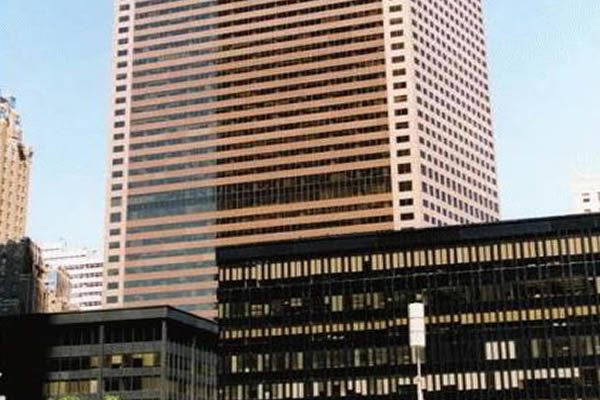The old 7 World Trade Center was a 47-story skyscraper that stood across Vesey Street north of the main part of the World Trade Center site (a new building has since been erected on the site of the old and opened in May 2006). Though not hit by a plane, it was hit by debris from the WTC towers and damaged by fires which burned for seven hours, until it collapsed at about 5:20 p.m. on the evening of September 11. Several videos of the event exist in the public domain thus enabling comparative analysis from different angles of perspective.
Some proponents of World Trade Center controlled demolition theories suggest that 7 WTC was demolished because it served as an operational center for the alleged conspiracy, while others believe the government also wanted to destroy key files held there about corporate fraud. According to a statement reported by the BBC, Dylan Avery thinks the building was suspicious because it had some unusual tenants such as a CIA field office and several government agencies. The former chief counter-terrorism adviser to the President, Richard Clarke, does not think that 7 WTC is mysterious, and said that anyone could have rented floor space in the building.
No steel frame high rise had ever before collapsed because of a fire.BBC News reported the collapse of 7 WTC twenty minutes before it actually fell. The BBC has stated that many news sources were reporting the imminent collapse of 7 WTC on the day of the attacks. Jane Standley, the reporter who announced the collapse prematurely, called it a “very small and very honest mistake” caused by her thinking on her feet after being confronted with a report she had no way of checking.
Steven Jones says the debris contained sulfuric compounds, suggesting that thermate, a mixture of thermitic materials and sulfur, might have been used to destroy the building.He asserts that videos show a yellow molten substance, which he identifies as iron, splashing off the side of the South Tower about 50 minutes after the airplane’s impact. According to Jones, pictures also show white ash of aluminium-oxide, another product of the thermite reaction. Professor Richard Sisson of Worcester Polytechnic Institute thinks the sulfur came from gypsum in the wallboards.The NIST’s question and answer page for the 7 WTC investigation also mentions the presence of sulphur in the gypsum wallboard, and states that an analysis of the steel for thermite or thermate would therefore not necessarily be conclusive.
In the PBS documentary America Rebuilds, which aired in September 2002, Larry Silverstein, the owner of 7 WTC and leaseholder and insurance policy holder for the remainder of the WTC complex, recalled a discussion with the fire department in which doubts about containing the fires were expressed. Silverstein recalled saying, “We’ve had such terrible loss of life, maybe the smartest thing to do is pull it”. “They made that decision to pull”, he recalled, “and we watched the building collapse.” Silverstein issued a statement that it was the firefighting team, not the building, that was to be pulled.

Following a three year investigation NIST released its final report on the collapse on November 20, 2008.Investigators used videos, photographs and building design documents to come to their conclusions. The investigation could not include physical evidence as the materials from the building lacked characteristics allowing them to be positively identified and were therefore disposed of prior to the initiation of the investigation.The report concluded that the building’s collapse was due to the effects of the fires which burned for almost seven hours. The fatal blow to the building came when the 13th floor collapsed, weakening a critical steel support column that led to catastrophic failure, and extreme heat caused some steel beams to lose strength, causing further failures throughout the buildings until the entire structure succumbed. Also cited as a factor was the collapse of the nearby towers, which broke the city water main, leaving the sprinkler system in the bottom half of the building without water.
NIST considered the possibility that 7 WTC was brought down with explosives. It concluded that a blast event did not occur and that the “use of thermite […] to sever columns in 7 WTC on 9/11/01 was unlikely”.The investigation noted that no blast was audible on recordings of the collapse and that no blast was reported by witnesses, even though it would have been audible at a level of at least 130-140 decibels at a distance of half a mile. NIST also concluded that it is unlikely that the quantities of thermite needed could have been carried into the building undetected. The theory that fires from the large amount of diesel fuel stored in the building caused the collapse was also investigated and ruled out.
World Trade Center developer Larry Silverstein said, “Hopefully this thorough report puts to rest the various 9/11 conspiracy theories, which dishonor the men and women who lost their lives on that terrible day.” Richard Gage, leader of the group Architects & Engineers for 9/11 Truth said, “How much longer do we have to endure the coverup of how Building 7 was destroyed?”.James Quintiere, professor of fire protection engineering at the University of Maryland, who does not believe explosives brought down the towers, questioned how the agency came to its conclusions, remarking, “They don’t have the expertise on explosives.” Quintiere said NIST wasted time employing outside experts to consider it.

